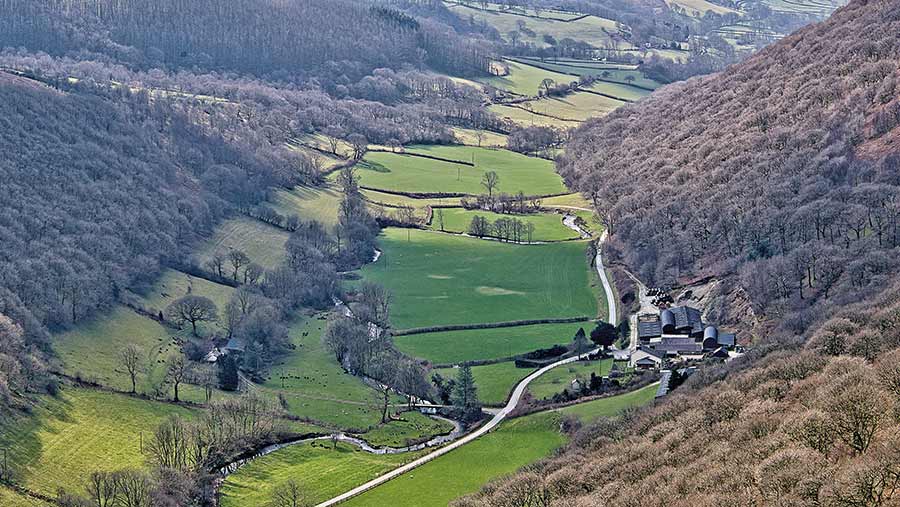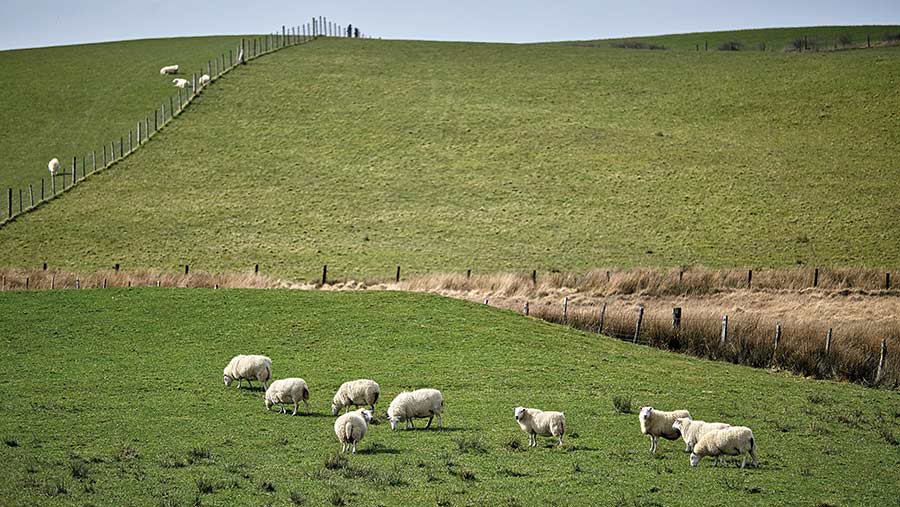Hedgerows and grazing are transition focus for upland farm
 Transition Farmer Irwel Jones © Richard Stanton
Transition Farmer Irwel Jones © Richard Stanton Better grazing management and more hedgerows are among the long-term targets for upland beef and sheep producer Irwel Jones.
A third-generation farmer, Mr Jones, took over the 375ha Aberbranddu Farm, near Llanwrda, Carmarthenshire, from parents Eirwyn and Heulwen in 2013.
He now tackles the challenging upland terrain in partnership with his wife, Charlene.
See also: How an upland farm is adapting to survive without subsidies
The land rises from 200m above sea level to 400m with areas of marsh and mountain about 20 miles from the coast.
“The farm is the first high ground to be hit by the weather and the 2,000mm of rain we get pretty much dumps itself on us.”
Farm facts: Aberbranddu Farm
- Farm size: 375ha acres (255ha owned and 120ha rented)
- Enterprises: sheep (Tregaron-type Welsh Mountain) – 950 ewes on owned land, 550 on rented area with Welsh and Aberfield sires used; suckler cows and followers – 40 continental crosses; root crops
- Annual rainfall: 2,000mm
- Soil: clay and peaty on marshy areas
Transition goals
- Carefully extend and manage natural woodland
- Plant hedgerows to improve biodiversity and aid pasture management
- Rely less on volatile inputs
Grazing management
Of the 375ha, just 150ha is improved. The remainder is rough grazing with steep-sided slopes and 80ha of ageing, natural oak woodland.
But Mr Jones is working to turn the challenges to his advantage. He hopes a balance of woodland and rough grazing will fit well with the future aims of policymakers.
The farm has long made use of environmental schemes with a decade in Glastir and years in Tir Gofal before that.

Aberbranddu Farm © Richard Stanton
Under the schemes, the farm planted hedgerows and trees. The aim is to continue with that process under the Welsh government’s yet-to-be announced post-Brexit agriculture plans.
Aware of the land grab and tree planting under way by large corporates offsetting their carbon outputs, Mr Jones says woodland improvement will be carried out sensitively.
“Tree planting is a good way to capture carbon, but we respect the natural aspect of the land and don’t want to plant rows of commercial conifers. It’s about getting the right tree in the right place,” he says.
Instead, trees will be deciduous species and in keeping with existing woodland within a site of special scientific interest.
It is natural but full of scrub and briar, and Mr Jones hopes to improve it by securing setup and maintenance grants.
Planting hedgerows
Likewise he expects there to be future funding for hedgerows which will support a major planting policy at the farm.
Hedgerows are central to the business’s future – they are likely to attract payments, but will also support a change in grazing management.
They provide shelter for stock up the hills and encourage biodiversity.
“We aim to break up large grazing areas into smaller fields, making grazing management more precise.
The aim is to use newly planted hedges to create up to 40 paddock areas, as opposed to the original 11 on the upper block.”
Over the past five years, Aberbranddu has been a demonstration unit for Farming Connect.
One project looked into rotational grazing, moving ewes every four to five days. It showed the production benefit of using smaller paddocks for rotational grazing.
“Surprisingly, with our rainfall, one challenge will be to get water supplied to each of the paddocks,” Mr Jones says.
“The water flows down the hill easily enough but it is trickier to get it to go back up.”
He intends to build ponds to collect water at the foot of the slopes and to use solar power to pump it up the hill.
The farm, already has a 7kW hydro-electric power generator, which has helped to protect the business from soaring energy prices.
Reducing inputs
Mr Jones also wants to look at ways of reducing reliance on other volatile-priced inputs, such as fertiliser, feed and fuel.
The farm has already improved pasture with a liming regime and makes use of the suckler herd to boost nutrients.
This has helped fields to carry heavier stocking rates and reduce fertiliser use by one-third to 40t/year.
Applications are underpinned by regular soil testing so that supply is tailored to meet precise requirements, rather than calculations and estimates.
Further reductions in fertiliser are targeted as the soil health continues to improve under rotational grazing.
The farm has not used bought-in feed for the past three years on the main flock, says Mr Jones.
During winter, sheep are on root tops, grown on 4ha of the farmland. But the extra field work and ploughing is carbon intensive.
Mr Jones hopes the improved grassland will allow him to drop the root crop venture in the future.
It may be necessary to trim the flock size by about 100 ewes to meet this aim, Mr Jones says.
Livestock would still be the main driver, but grazing and production would be more in balance and, therefore, more sustainable.

Tregaron-type Welsh Mountain sheep © Richard Stanton
Irwel Jones is one of our Transition Farmers. Join him as Aberbranddu Farm strives to become financially and environmentally sustainable and overcome the challenges it faces over the next five years.
